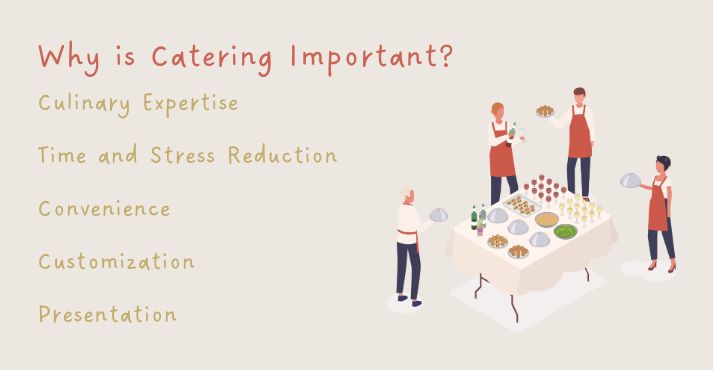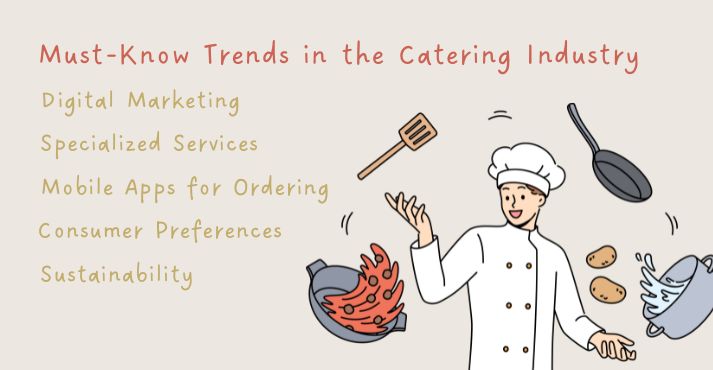We often need catering services for different occasions, events, and gatherings.
Despite being an industry where people interact daily, they don’t know what the term catering means.
So, what is a catering service? Catering refers to business in a service industry providing food and hospitality outside a conventional setting, such as events or remote locations.
The catering industry is very competitive and cutthroat. Despite several ongoing challenges, the catering market is poised to grow.
To help you learn more about this all-important industry, we have put together our guide on better understanding Catering.
Why is Catering Important?

No matter what, food is the only thing that people remember after the event is over. This is what makes caterers so important to events.
Here are some of the reasons why Catering is essential:
Culinary Expertise
Professional caterers offer culinary expertise, ensuring high-quality, delicious food that impresses guests and creates memorable dining experiences.
Time and Stress Reduction
Catering saves time and alleviates the stress of cooking, serving, and managing an event, enabling hosts to enjoy the occasion and interact with guests.
Convenience
Catering simplifies event planning by handling menu creation, preparation, service, and cleanup, allowing hosts to focus on other aspects of their event.
Customization
Catering services can tailor menus to meet specific dietary preferences and cultural requirements, ensuring everyone’s needs are met.
Presentation
Caterers excel in food presentation, enhancing the visual appeal of dishes, which elevates the overall atmosphere and guest experience.
From food to drinks, catering services offer various options to suit your budget and taste. Catering services save time and lessen your burden, providing service and delectable food while you carry on with the event.
As we move forward, the catering industry serves the following two categories of customers:
1. Business-to-Business Catering
This type of customer usually places orders for regular events such as training events, meetings, business events, staff meetings, presentations, company events, etc.
2. Consumer Catering
This type of customer usually places orders for special occasions such as birthday parties, funerals, weddings, etc.
The History of Catering
As the catering industry today becomes highly refined, and guests can expect nothing but the best services, the landscape has evolved over the years.
Let’s dig into the history of Catering.
Ancient Catering
Catering has existed for a long time, even as far back as 4,000 years ago. In ancient places like Egypt, Greece, and Rome, fancy parties were familiar among the rich, who needed cooks and servers to make and serve the food.
In ancient China, Catering was done mainly by royal and noble families. So, the idea of serving food at special events has been around for ages in different parts of the world.
Medieval Catering
In the Middle Ages, parties and big dinners were quite popular. People loved celebrating and being friendly. And things started to get more organized.
Places like inns and taverns began to serve food to travelers. However, fancy feasts were still mainly for rich people. What you could eat depended on the rules of your religion and what was in season.
As people traveled more and went on Crusades, they discovered new foods and cooking tricks. Spices became necessary, and they learned new ways to make food look nice and taste great. So, the Middle Ages saw the catering business grow and change a lot.
Renaissance Catering
During the Renaissance period of transformation, Catering changed a lot. Cooks and servers formed groups to become professionals. They made food look like art, and parties were a way to show off new dishes.
People used a lot of spices and tried to use fresh, local food. Inns and taverns, like hangout spots, often offered Catering. They also started making cookbooks, which showed how much better they got at cooking and serving fancy food.
Global Catering Market Statistics
As we go through the catering industry overview, here are some key statistics shared by GlobeNewswire.
- The global catering services market is predicted to expand at a CAGR of 4.5% and reach a valuation of US$ 908.8 billion by the end of 2033.
- Among regions, East Asia exhibits the fastest growth, with a CAGR of 5.3%.
- Contract catering services capitalized about 71.0% of the share in the service segment.
- From 2023 to 2033, the market will expand with a CAGR of 4.5%.
Catering Industry Trends

The catering industry is entering an exciting period with merging trends and innovations driving growth. From digital advancements to the emergence of specialized services, Catering is evolving.
Here are the key trends likely to shape the future of catering over the coming years.
Digital Marketing in Catering
The catering industry is leveraging users’ increasing use of social media platforms worldwide to interact, engage, and communicate with customers. Catering companies ensure cross-platform presence to improve brand awareness, increase visibility, and drive more leads.
Increased Focus on Sustainability
With climate change and environmental protection at the top of many people’s minds, the catering industry is looking for ways to reduce their environmental impact by utilizing renewable energy sources, cutting back on single-use plastics, and investing in eco-friendly product packaging. Also, consumers are looking for caterers that use sustainably sourced ingredients in their food.
Changing Consumer Preferences
Customer demands and needs are changing constantly, higher than ever before. Customization and personalization have become the keys to success. Catering businesses need to accommodate customer requests quickly and efficiently.
Use of Mobile Apps for Ordering
Mobile apps have eliminated a lot of paperwork and become a new tool for catering businesses to reach a broader customer base. Customers prefer to order from convenient apps that easily browse menus, confirm orders, track progress, and even make payments with a single tap.
Rise of Specialized Services
As competition in the catering industry intensifies, catering businesses are offering specialized services based on preferences, ingredients, and tastes to stand out in a crowded field.
Types of Catering

The nature of the catering business is dynamic and evolving with the changing consumer preferences worldwide. Knowing the classification of the catering industry based on on-premise and off-premise Catering, you’ll be able to identify which options suit you the best.
1. On-Premise Catering
On-premise Catering refers to the Catering done within the kitchen and food preparation areas of the exact location. Typically, this means the food for your event is prepared and served on-site.
Here are the different venues and unique aspects of each offering on-premise catering services:
- Hotels
Hotels offer convenience with accommodations, diverse event spaces, and experienced staff, making them ideal for significant events, conferences, and weddings.
- Restaurants
Restaurants offer diverse cuisine options, intimate atmospheres, and personalized menus for smaller gatherings, rehearsal dinners, or themed events.
- Banquet Halls
Banquet halls are versatile for large gatherings, featuring customizable decor and ample amenities for weddings, galas, and corporate events.
- Cruise Lines
Cruise lines offer unique venues for destination weddings, corporate conferences, and private parties while cruising to picturesque destinations.
- Country Clubs
Country clubs provide an elegant setting with golf course views, making them suitable for weddings, golf outings, and social events with a touch of sophistication.
- Resorts
Resorts combine beautiful settings with all-inclusive packages, making them perfect for destination weddings, leisure events, and outdoor gatherings.
- Private Clubs
Private clubs offer exclusivity, personalized services, and elegant settings for upscale events, such as member gatherings, galas, and private celebrations.
- Religious Groups
Religious groups provide traditional settings for weddings, religious ceremonies, and cultural events, combining spiritual significance with meaningful celebrations.
2. Off-Premise Catering
Off-premise catering catering refers to bringing in food that had been prepared at another location beforehand. Trust and familiarity are what constitute off-premise Catering.
Here are some of the critical variations in off-premise Catering:
- Mobile Catering
Mobile Catering offers flexibility, bringing food to various locations via trucks or trailers. It caters to diverse crowds with on-the-go convenience and is ideal for festivals, fairs, and outdoor events.
- Specialized Services – Kosher Catering
Kosher Catering ensures the highest standards of food preparation. It is for kosher observant clients, guaranteeing dietary and cultural requirements are met.
How do you develop your Identity or Signature Style?
A strong brand identity is not a luxury; it is a necessity for businesses to stand out from the crowd. With the correct and complete catering knowledge, you can develop your unique signature style and brand identity that reflects your values.
Targeting Niche Markets
Niche marketing allows you to focus your marketing efforts on a specific group of people more likely to be interested in your catering services. By identifying your niche market and its unique needs, you can craft a tailored marketing strategy that resonates with your audience.
By focusing on a specific market, a catering company can develop a unique offering that may not be available from competitors.
Do you know how to choose a niche in Catering? Consider these steps:
- Your unique style
- Location
- Analyze competitors
- Define menu & pricing
- Refine niche
This way, you can craft a unique niche and focus on catering to consumers, gradually expanding into other niches. By continuously adapting to clients’ needs, caterers can establish themselves as top choices in their chosen niches and drive business growth.
Customizing Services
Tailoring menus, themes, and service styles to specific clientele or event types enhances appeal and meets unique preferences.
Customization offers a competitive advantage, setting the business apart from generic catering services. It allows for targeted marketing, personalization, and word-of-mouth referrals. It encourages flexibility and innovation, enabling the development of creative, niche-specific offerings.
Catering service specialization in vegan cuisine, cultural themes, or corporate wellness fosters expertise and trust.
Example: Specific type of Catering
For example, with the growing interest in plant-based diets and vegan options, you can focus on this unique niche as a caterer. You can provide high-quality, creative, and delicious vegan dishes for consumers and businesses that want to promote health and environmental responsibility.
Another excellent example of a niche in the catering business is cultural subscription boxes that introduce people to different cultures and cuisines interactively.
Factors That Can Affect the Catering Market
There are several factors affecting the catering market. These include changing consumer preferences for diverse cuisines, dietary restrictions, and health-conscious options. Economic conditions, evolving hospitality industry trends, and the role of automation and technology in the catering industry are key aspects impacting businesses.
Growing Demand for Healthy Options
As health consciousness grows, customers seek more health-conscious food options from their caterers. According to Deloitte Insights, despite inflation, consumers still consider health and wellness when purchasing fresh food.
Gig Economy Impact on Catering Businesses
The gig economy poses challenges and competition for the catering business, where temporary and freelance positions are becoming increasingly common. It has increased competition and enticed caterers to become more agile and responsive to customer needs.
Automation & Technology in Catering
With dramatic advancements in technology, the catering industry is no exception. Augmented reality (AR) and virtual reality (VR) are helping catering companies deliver better customer service and interactive experiences.
Also, various software and automated systems, such as inventory management and payment processing tools, are developed to improve restaurant operations, allowing catering companies to focus on providing better customer service.
Food Safety and Hygiene in Catering
Cleaning, cooking, cross-contamination, and chilling are the 4Cs of the catering industry that cover essential food hygiene and safety practices. Basic hygiene principles should be applied at each stage of the operation.
Regulations and Standards
Food safety regulations and standards involve maintaining proper temperatures, ensuring food is sourced from reputable suppliers, and implementing sanitation and hygiene practices to prevent contamination.
Training and Certification
Catering staff should undergo training and certification to help maintain the highest level of safety and hygiene in catering operations, reducing the risk of foodborne illnesses and ensuring customer satisfaction.
Conclusion
The catering industry is a multifaceted and dynamic field with deep historical roots and has evolved throughout history. Today, the industry has grown to encompass a diverse array of services, offers a variety of catering types, from on-premises to off-premises, and 0perate in a multitude of venues.
Now that you know what a catering business is and how the industry has evolved over the years, you must have a better idea of where to start your business journey.















